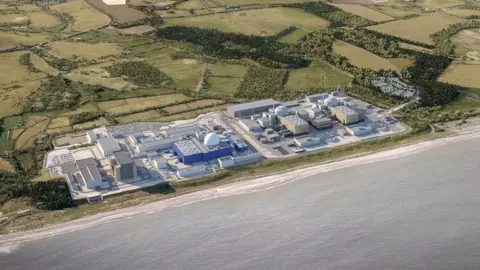The UK government has announced a substantial commitment of £14.2 billion for the construction of the Sizewell C nuclear power plant located along the Suffolk coastline. This decision comes just ahead of an upcoming Spending Review, underscoring the government’s push for major infrastructure development as part of its energy strategy. This investment is intended not only to boost energy production but also to create significant employment opportunities, estimating around 10,000 direct jobs alongside thousands more in supply chains supporting the plant.
Chancellor Rachel Reeves heralded the approval as a landmark decision, emphasizing its potential to stimulate economic growth. She described the project as a vital part of the UK’s energy future, stating that Sizewell C would represent the “biggest nuclear building program in a generation.” Alongside her, Ed Miliband, the Energy Secretary, remarked on nuclear energy’s promise to usher in a “golden age” of clean energy and reinforce the country’s energy security. The government is positing that the move towards nuclear energy is critical, providing low-carbon and stable energy that is not reliant on weather conditions.
However, the announcement has not been free from opposition. Alison Downes, director of the campaign group Stop Sizewell C, criticized the decision, suggesting that it would ultimately be a costly error for the government. She believes that the public funds could be better used for other pressing needs and fears that the project could inflate consumer bills. Downes pointed out that while the government has committed sizeable funding, details regarding the total costs remain murky, and negotiations for private investment are not yet complete. Her organization and other locals have voiced concerns, stating that they believe the project may not align with the long-term energy needs of the population.
Despite these criticisms, the approval of Sizewell C has been framed as necessary, especially given the long timeline associated with nuclear projects. Similar projects, like Hinkley Point C in Somerset, have faced delays and cost overruns, with officials indicating that Sizewell C could take at least a decade to complete. Critics worry whether the expected energy output and job creation will justify the long-term investments required for such projects, especially considering the past challenges faced by similar initiatives.
Public sentiment around Sizewell C has been polarized, evident in a protest that occurred on Sizewell beach where approximately 300 demonstrators voiced their opposition to the plans. The conflicts surrounding this project reflect a broader debate regarding energy policy in the UK: balancing the urgent need for energy security against the increasing scrutiny of large-scale infrastructure projects and their potential environmental impact.
As the government prepares for the upcoming Spending Review, which is set to delineate expenditure plans across various departments, further announcements regarding Sizewell C’s funding model are anticipated later this summer. This will likely detail how the government aims to secure additional investment and manage the financial implications of the nuclear project moving forward. The review is also expected to include other policies impacting key sectors such as defense and technology, indicating a significant moment for the government as it addresses various national priorities.
Sizewell C is intended to provide substantial energy output, sufficient to power six million homes, thereby contributing to the UK’s overall energy mix. Additionally, the government has indicated plans to invest £2.5 billion into researching and developing fusion energy, striving for advancements in its defense nuclear sector. As this ambitious nuclear project unfolds, its various implications for energy policy, environmental considerations, and economic growth will continue to be scrutinized and debated in both local and national arenas.
This announcement highlights the UK’s strategic direction towards nuclear energy, spawning discussions about its feasibility, the integrity of investment strategies, and the voices of those who challenge such monumental undertakings. This juxtaposition of ambition and skepticism embodies the current landscape of energy discourse in the nation.



